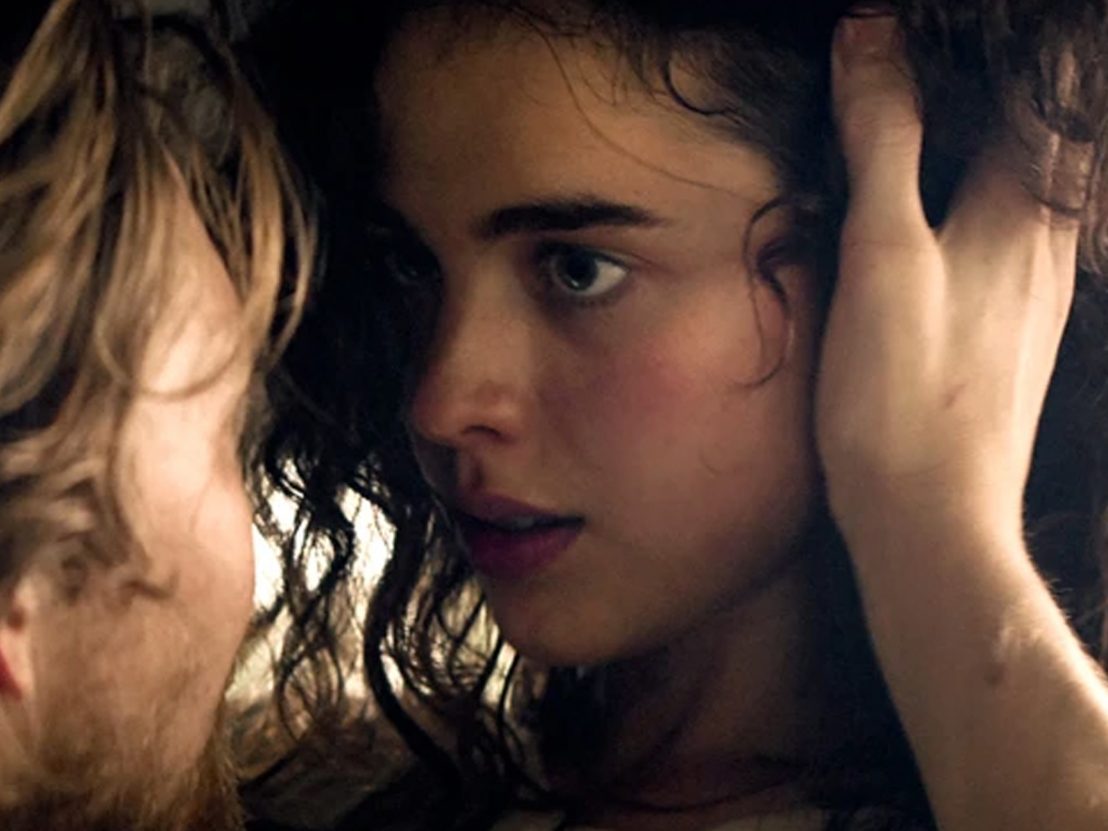
In a new series, we’re celebrating the films we loved that aren’t likely to dominate the awards race. Over the new few weeks, our writers make passionate arguments for the performances and craft that stood out to them, from blockbusters to arthouse and everything in between.
A dark green military jacket hangs, protected in a transparent dry-cleaning bag, filling most of the screen. We can hear two things: a man gasping repetitively, and, almost as loud, the whirring of a fan. The plastic bag stirs in the unseen fan’s breeze. The camera tilts through a downward trajectory, abandoning the uniform’s lapels, cluttered with the insignia of rank, to take in the empty sleeves and cuffs, hanging, lifeless, powerless.
We know, or can guess, the identity of the jacket’s owner. He’s the same guy who is making ostentatious sex noises. We’ve met him fully clothed in the previous scene. This jacket shot unfolds about four minutes into Stars at Noon, and we have been introduced to only two characters. The first is Margaret Qualley’s Trish, the second is this guy, Subteniente Verga (Nick Romano).
They’re an odd couple. Trish is a soi-disant journalist in limbo, who has written a piece covering extrajudicial killings in Nicaragua, where the film is set, thereby angering local political leaders. From the first moment we see her Qualley embodies a plausible mixture of street smarts blended perilously with childlike impulsiveness.
Subteniente Verga is not someone about whom we will come to care a great deal. He is having sex with Trish following a short scene best described as anti-foreplay, in which she attempts to evade him by hiding in the sweaty bathroom of a fast food joint. Verga discovers her, and the film cuts to the subsequent sex scene.
The camera finds Trish on top of Verga, moving rather mechanically, to his apparent enthusiasm. The whirring fan is now visible immediately behind Trish. The sound design draws our attention to the fan, which dominates the mix. The hot and humid climate has been emphasised in the previous scene; we can almost feel the cool air from the fan on Trish’s bare skin. Verga possibly has the same thought, efficiently flipping Trish over and onto her back. Now on top of her, he benefits from the loudly whirring fan, and redoubles his efforts. All that we can hear is the sound of that fan and the sound of his moaning; the mix is masterfully calculated to convey profound loneliness.
There follows a short and angry postcoital scene, the lovers as disconnected as they were when they were having sex.
Stars At Noon then repeats these exact three steps: foreplay, sex scene, postscript. But this second time, the dance is with a different partner. Once more, sound design is crucial to our understanding of the dramatically different dynamic.

After a short taxi ride set to Tindersticks’ woozily improvisational soundtrack (which throughout the film suggests Trish’s directionless state of being), Trish pitches up at a clean but cold hotel, all hard echoey surfaces and low-key air-conditioning thrumming in the background. She slouches to the bar, where Daniel (Joe Alwyn), a white Englishman with blond hair and a patchy beard is drinking a solitary drink. He is amused by her effortful projection of world-weary cynicism. The score continues through this scene, slipping into a lazy bossa nova, giving the couple’s interaction the feel of a tentative duet, where the preamble with Verga (set to nervous mood music) felt confrontational and individualistic.
This introduction is not exactly romantic – he asks if she’s “for sale”, she dodges the question, then later admits “for a price, I’ll sleep with you”. We’ve barely had time to process hearing this sentence when the film cuts to footage of the pair in bed, shot close up, an expanse of white skin filling the screen, and this time we can hear that Trish is enjoying herself as much as her partner; the sound design builds on the idea that this is a duet, not a solo act of gratification. The visual emphasis is on hands and tight close-ups that frame shoulders, torsos, backs; it’s sometimes hard to tell who is who, whereas with Verga the camera stood back more, to show us individuals at a distanced remove.
Again, Trish and Daniel’s postcoital chat isn’t sweet or romantic – it covers payment for sex, adultery, politics – but it is intimate; while both keep up a cynical front, delivering every line in an affectless monotone, they almost inadvertently also reveal their deepest fears (“I feel like I’m in danger of throwing my life away”).
Their environment is cold – we can hear the air-conditioning, we can see they aren’t sweating like Verga was – a sonic landscape that gives an added sense of precariousness to these sparks of vulnerability in the dialogue, these tiny snippets of warmth which flare briefly but can’t possibly catch fire. Or can they? As Trish walks away from the encounter, Tindersticks’ score strikes up again. Smoky and tentative as ever, there’s just enough warmth there to suggest something has indeed caught light, despite everything. The name of Denis’ preferred musical collaborators has never seemed more apt.
These scenes are not the only moments where sound is important in Denis’ film (it is always important), but sound design is best conveyed through an analysis of the microcosm. Funnily enough, the most discussed little fragment of Stars At Noon is also sound-related, and has been lambasted all over the internet. Lying on his back, Daniel says, in a gravelly voice, thick with desire: “suck me.” Shorn of context, posted online, it is appalling.
When I try to remember stuff I’ve said in the heat of the moment during sex, there aren’t very many moments where I can look back, complacent in my triumphant certainty that I selected le mot juste. Nor should there be – good sex is a creative and improvisational act. It would be monstrously limiting to be haunted at such moments by a self-critical inner editor. Denis understands this, and in giving Alwyn a cringe line calculated to repulse any tasteful inner editor, she captures perfectly a moment when that critical voice has been banished.
This is especially meaningful when you consider how Alwyn’s character stands for a particular type of Englishness, generally associated with John le Carré, an Englishness dedicated to the legacies of Empire, to white suits, good taste and stiff upper lips. The sex between Trish and Daniel is sometimes vulgar, sometimes erotic, occasionally embarrassing, always desperate, always real. It’s a spontaneous act of abandon, in which middle class anxieties over good taste have gone out the window.
This is why Stars At Noon works – not because it colours carefully within the lines, but because of its precise evocation of something messy. Whether you agree that this is deliberate will depend to a large extent on the degree of intelligence and intention with which you’re prepared to credit the filmmaker who gave us 35 Shots of Rum, Trouble Every Day, and Beau Travail.
Published 10 Mar 2023

Claire Denis adapts Denis Johnson’s 1986 novel about love in a time of revolution – with fascinating, if not entirely successful, results.

Claire Denis contemplates existence, evolution and survival in deep space with Robert Pattinson and Juliette Binoche.

Juliette Binoche and Vincent Lindon deliver the dramatic goods in French master Claire Denis' nuanced exploration of married life.